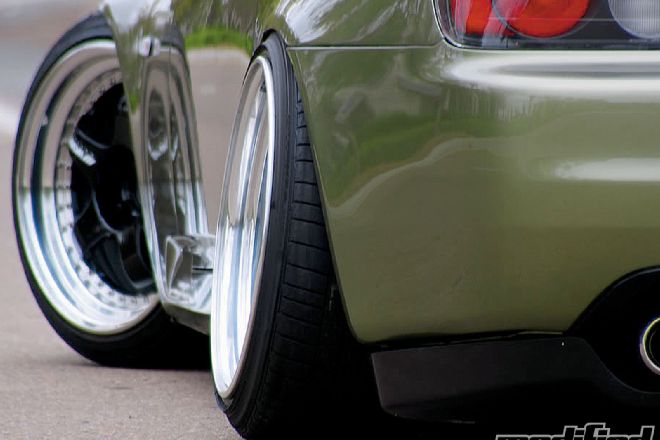It's hard to resist the look of an aggressively lowered car with a sexy set of flush-mounted wheels and tires. This is, after all, a styling cue taken directly from the motorsport world. Just look around the paddock at a Touring Car race or Formula D event and you'll notice a conspicuous absence of fender gaps and ground clearance.
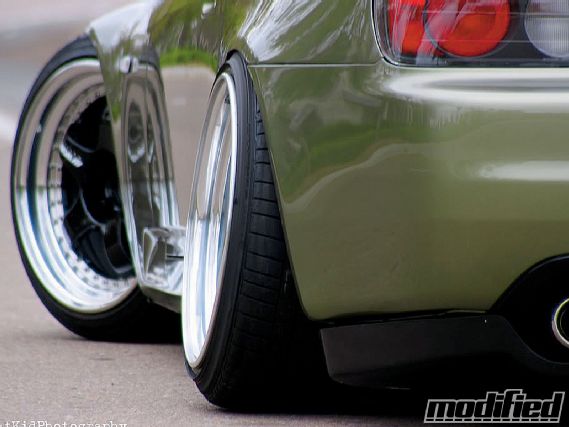 |
Aggressive Wheel Offset - Hellaflush Gone Wild
|
Aggressive Wheel Offset - Hellaflush Gone Wild
That's because these purpose-built race cars are equipped with reinforced hubs and wheel bearings, stiffened suspension with reset or completely reworked geometry, and body and aero packages designed for minimal drag, maximum downforce and a wider track. These highly sophisticated and carefully engineered modifications make what would appear to be impossibly low ride height and super-aggressive wheel offset work extremely well in a high-performance environment.
Which brings us to the current automotive styling trend of super-aggressive wheel offset and super-low ride height known best by the word "hellaflush." Just to be clear, I'm not a hellaflush hater by any means - I consider automotive stylists like Jayson Pizarro and the Fatlace crew to be very important trendsetters within the industry. The thing is, guys at the forefront of the scene like Jayson understand how to achieve a very aggressive wheel offset and super-low stance without overly compromising the performance of their vehicle, but the average Joe out there who wants to slam and stretch his car's stance may not fully understand the consequences of doing so in a quick, half-baked way. So let's take a look at what happens to your car's handling and steering when you stuff super-aggressive offset wheels and tires under it and dump its ride height to the ground.
Although most properly designed coilover kits these days include independent adjustment for ride height (and spring preload), there's still a limit to how low you can go before you start to compress the shock and lose travel. Go past this point in search of a super-low stance and the results will include rapid deterioration of the shock's valving because they're being forced to operate in a reduced range, not to mention harsh and inconsistent ride quality and handling as the car's weight transitions from the coil springs to the bumpstops to the physical limit of the shock absorber's range of travel (where it has infinite spring rate as it bottoms out).
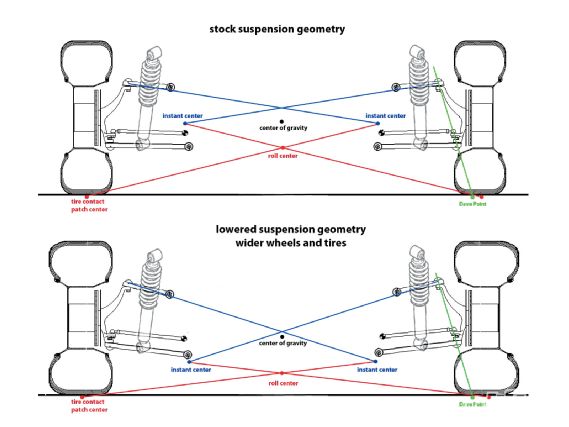 |
Aggressive Wheel Offset - Hellaflush Gone Wild
|
Aggressive Wheel Offset - Hellaflush Gone Wild
Even more detrimental than the loss of suspension travel and ride quality are the changes to your car's suspension geometry. For those of you who aren't too sure what the term "suspension geometry" really means, it refers to the relative positions and angles of the suspension arms/links and how their positions change as the wheel travels over a bump or the car's weight transfers during braking, acceleration or cornering.
As you would expect, the geometry of a car's suspension is designed at the factory to have as close to optimum camber and toe curves as possible - meaning as the wheel travels on the arc determined by the car's suspension design, changes to wheel alignment are kept to a minimum. This provides the most stable and predictable handling, so altering your car's suspension geometry by aggressively lowering it can result in a number of unwanted side effects.
When you lower your car's ride height, you may not realize you're also lowering its roll centers. The roll center is simply a point in space, located by first identifying the suspension's instant centers (see diagram, page 14), upon which the vehicle rotates when cornering. This is important because as you lower a car's ride height you increase the distance between its roll center and its center of gravity, resulting in more body roll and slower steering response. The additional body roll also means the inside tire is used less effectively, resulting in less overall grip. So even though lowering your car does reduce its center of gravity and weight transfer, the even greater reduction of its roll centers means your car is going to have increased body roll and potentially less grip.
Another unwanted effect of lowering a car too aggressively is bumpsteer. The simplest definition of bumpsteer is the wheel's tendency to steer or change direction when encountering a bump. This happens because as a wheel hits a bump its shocks/springs compress and its suspension geometry changes as the wheel travels upward over the bump, resulting in changes to wheel alignment and the sensation of the car trying to change direction.
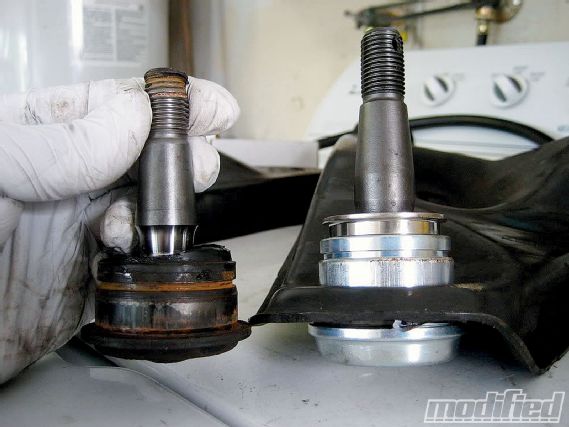 |
As you lower your car's ride height, you lower its roll center by a greater amount than you lower its center of gravity, leading to more body roll if you don't install roll center adjusting lower ball joints.
|
As you lower your car's ride height, you lower its roll center by a greater amount than you lower its center of gravity, leading to more body roll if you don't install roll center adjusting lower ball joints.
It's not difficult to locate the steering tie rods so that there's no issue with bumpsteer, but most automakers have to compromise on this due to packaging constraints associated with locating the steering rack. Most unmodified cars experience only minor bumpsteer, but as you lower a car's ride height its tendency to bumpsteer becomes amplified by the changed angle of the tie rods relative to the steering rack and lower control arms. On aggressively lowered cars, the effects of bumpsteer make for an evil handling machine, one that feels like it's constantly trying to change directions unpredictably as it encounters bumps in the road. It's a very unsettling feeling as a driver and one that has no doubt left more than a few wannabe hellaflushers scratching their heads.
Adding to the sensation that your dumped and stanced ride has a mind of its own is the extra steering effort and steering kickback that comes with a more aggressively offset wheel/tire package. A wider track reduces weight transfer (and a wider contact patch should improve cornering power), but changes to steering geometry will reduce steering feel and produce unwanted kickback through the steering wheel. This is because, as all you old Sport Compact Car readers will remember from Dave Coleman's Technobabble column, increasing wheel offset changes the distance from the wheel center to the point where the steering axis intersects with the ground, a point Coleman quite humorously named the Dave Point. You can go to a wider wheel and tire with OE offset and not upset steering geometry because the Dave Point remains at or near the center of the contact patch (its ideal location, though in most cases it's slightly inboard and to the front due to design constraints), but the more aggressively you change wheel offset and stretch/widen the contact patch, the more you increase scrub radius and move the Dave Point away from the center of the contact patch, resulting in reduced steering feel and increasing steering kickback.
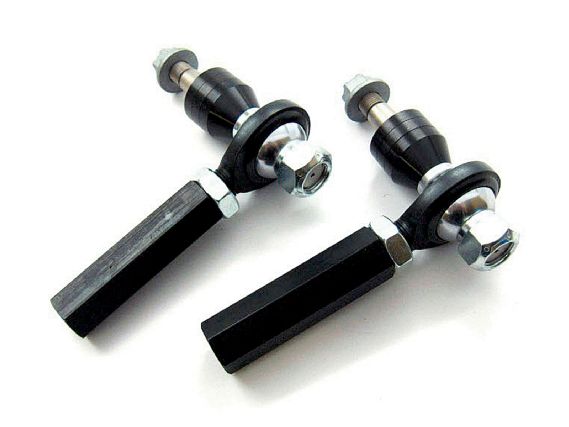 |
Adjustable tie rod ends allow you to set their angle back to stock, eliminating any bumpsteer that would otherwise result from an aggressively lowered ride height.
|
Adjustable tie rod ends allow you to set their angle back to stock, eliminating any bumpsteer that would otherwise result from an aggressively lowered ride height.
The good news is that there are ways to address many of the unwanted side effects of a hellaflush stance. Roll center and bumpsteer adjusters are widely available and can help reduce unwanted changes to suspension geometry as you lower your ride. Increased spring rates, high-quality short stroke dampers and stiffer antisway bars can also help keep your oil pan off the ground when encountering bumps and reduce body roll and the likelihood of the tires attacking the fender lips. And going with a wider wheel to fill up the wheelwells, rather than a more aggressively offset wheel, can help keep the Dave Point closer to home.
Ultimately, you'll be making some sacrifices in the name of style if you really want to explore the limit of hellaflush wheel fitment and ride height, but with a bit of effort to correct suspension and steering geometry you can have a car that isn't going to try to kill you every time you hit a bump or dodge a pothole.

